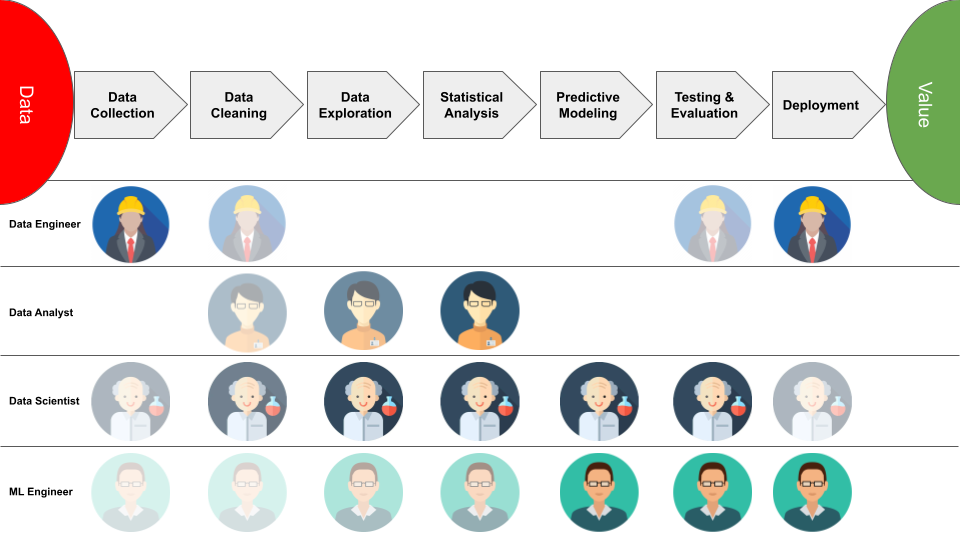
By Katherine Olowookere
November 19, 2022


Access O'Mentors
Top Data Scientist Mentors from Fortune 500 Companies excited to help you out 1-on-1!
1️⃣ Explore freely
→
2️⃣ Apply confidently
→
3️⃣ Pay securely
→
4️⃣ Book instantly
The recent advancements in technology has enabled the creation, storage, and analysis of ever-increasing amounts of information. This has consequently caused an explosion in the volume of available data. An astounding 2.5 quintillion data bytes were produced daily in 2020.
But frequently, this data just sits untouched in databases and data lakes. Business organizations are starting to realize that the vast amounts of data that these technologies collect and store can have a transformative impact on both their organizations and global societies if they know how to interpret them. This is where data science comes in.
You might be surprised that there isn't just a single job role within Data Science. According to Data Science Central, the data science profession has over 400 labels attached to it across several organizations. But generally, they are divided into 4 major categories:
- Data Engineer,
- Data Analyst,
- Data Scientist, and
- Machine Learning Engineer.
In this article, we will explore each one of these roles, what they do in organizations, and the tools they use in solving business problems. Let's explore each one of them.
Different Shades of Data Science

1. Data Engineer
Data engineers control the flow of Data. They are responsible for building data pipelines and storage solutions that ingest data from multiple sources. These data pipeline sources transform data into structures needed for analysis.
Data engineers design infrastructures that make the collection and accessibility of data easy. Generally, they are responsible for managing data access in a company.
Within the Data Science workflow – (Data collection and storage, Data Preparation, Exploration and Visualization, Experimentation and Prediction), the Data engineer focuses on the first stage– Data Preparation and Data Storage.
Data engineers typically have a background in computer science, computer engineering, programming or any other related IT field. They are usually excellent in coding and working with databases and cloud tools.
Tools used by Data Enginseers
A data engineer must understand the most efficient ways to access and manipulate data. To work with data, data engineers employ specialized tools like:
- Shell in the terminal command line interface (CLI) to automate and run tasks,
- SQL (Structured Query Language) to store and organize Data,
- ETL tools to move data between systems (ETL stands for Extract Transform Load),
- Java or Python to process files, and
- HDFS and Amazon S3 to store and move the data
Now more than ever, data engineers need to be comfortable with cloud computing (Azure, AWS Google Cloud Platform, etc) to ingest and store large amounts of Data. Data engineers can increase the performance of data scientists. Thanks to them, Data scientists can fully concentrate on their strengths: Research and Modeling.
2. Data Analyst
Data Analysts describe the current business via data. They perform simple analyses that describe the current and past data and then create dashboards and reports to summarize the results of their analysis.
A Data Analyst may utilize their expertise to assist a business in deciding which goods to stock in their stores or how to price those goods.
Data Analysts require less programming and statistics experience compared to the other roles. These professionals are expected to be effective communicators who are excellent at sharing findings with business stakeholders. Within the Data Science workflow, Data Analysts focus on the middle stages – Data Exploration, and Visualization.
There are different types of Data Analysts (Medical and healthcare analysts, Business Intelligence analysts, Market Research analysts, etc).
Tools for Data Analysis
Data Analysis tools assist in uncovering key insights that lead to more informed decision-making. Some of the tools used by Data Analysts include:
- SQL to retrieve and aggregate data
- Spreadsheet e.g (Google sheets and Excel) to perform analysis
- Business intelligence tools/BI tools for Data visualization and dashboards e.g Tableau, Power BI, etc.
- SPSS and VBA
SQL is used by both Data Engineers and Data Analysts. While data engineers build and configure SQL storage solutions, Data analysts use existing databases to retrieve and aggregate data relevant to their analysis.
Some more advanced data analysts are skilled and comfortable with using Python and R for cleaning and analyzing data. Before Data Analysts can carry out an analysis they usually have to clean the data and data cleaning alone can take a lot of time and effort.
3. Data Scientist
Data Scientists usually have a strong background in Statistics. They are responsible for analyzing data to identify patterns and trends and interpreting the data to discover solutions and opportunities.
Data Scientists require a deep knowledge of Math and Statistics. A natural sense of curiosity is also important, as this role requires a high level of creativity and critical thinking.
Data Scientists’ strong background in Statistics enables them to find new insights into data rather than just solely describing data. This special ability in Data Scientists makes them different and unique from Data Analysts.
Data Scientists also use traditional Machine Learning for making predictions and for forecasting. Within the Data Science workflow, they focus on the last stages of Data Experimentation and Prediction.
Tools used by Data Scientists
Data Scientists are usually proficient in the following tools:
- SQL to retrieve, manipulate and aggregate data,
- Python and/or R programming language. Python contains some popular data science libraries such as pandas, sklearn, etc
4. Machine Learning Engineer
Data Scientists and Machine Learning Engineers are comparable, but the latter specializes in Machine Learning.
Machine Learning is perhaps the major topic of conversation in Data Science. Machine Learning is a branch of artificial intelligence (AI) that focuses on developing systems that create new capabilities or enhance existing ones based on the data they are fed.
ML Engineers use training data to classify larger uncontrolled data. These scientists go beyond traditional Machine Learning done by Data Scientists with advanced algorithms such as Deep Learning.
Just like Data Scientists, ML Engineers also focus on the last stages in the Data Science workflow but with a deep focus on Prediction and Experimentation, the last stage of the DS workflow.
Tools used by Machine Learning Engineers
ML Engineers use various tools including:
- Python and/or R to create Machine Learning models with libraries like TensorFlow or Spark etc. These libraries are used to create advanced Machine-Learning algorithms in various branches of Machine Learning such as Natural Language Processing (NLP) and Image Processing.
Data Science has emerged into an all-inclusive job role that encompasses data mining, business analysis, predictive modeling, quality analysis, etc. As the field keeps growing, so does the demand for professionals. In O’Fallon Labs we offer professional services to help individuals prepare for Data Science roles through hands-on Training Programs and 1-on-1 Mentorship Programs led directly by top Data Scientists.